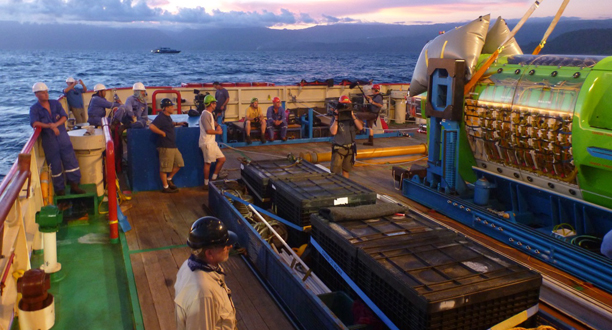Camera Hell

Jacquinot Bay, New Britain Island, Papua New Guinea
Yesterday, Jim tried to take the DEEPSEA CHALLENGER on a test dive to 3,281 feet (1,000 meters). He was in the water for less than an hour when technical difficulties with the boom camera and life-support system brought him back to the ship. The plan today is to fix the problem in the morning and dive the sub early in the afternoon.
This is the second day the Mermaid Sapphire has been positioned at the mouth of this magnificent bay on the south side of New Britain Island. At 9:30 a.m., the ship’s deck crew eases the first lander into the ocean and it falls to the seafloor, 2,953 feet (900 meters) below the keel of the ship.
Meanwhile, the sub team is inside the hanger preparing the sub for the dive. Walt Conti and Ty Boyce are filling the steel shot container, John Garvin and Ben Orchard are checking components in the crew sphere, and Adam Gobi and Bruno Brunelle are doing an immersion test on the boom camera.
At 1:40 p.m., the second lander is deployed and comes to rest 230 feet (70 meters) away from the first. When Jim walks into the sub hanger a team member looks up and says, “Good luck today.” Jim smiles. “This is one dive I’m really looking forward to,” he says.
At 3:20 p.m., Jim is inside the crew sphere going through the 60-item predive checklist. It starts with the emergency battery—emergency breaker on, VHF radio breaker on, heated suit breaker on—and includes the weight release battery and the circuit breaker panel. Only a few days ago, it took five hours to complete. Now, the two men are moving much faster. Standing next to the crew sphere I hear John Garvin’s voice: “Circuit breaker panel, all on. L3 modem in voice mode.”
As the sun sets over the purple mountains to the west, Jim is still inside the sub. He’s checked the shot dump, weight release, and thrusters. He’s checked the LED lights and the manipulator arm. He tries to adjust the focus and iris of the sub’s external cameras and there’s no response. He tries again—and again. The cameras on the boom and the manipulator aren’t just for high-resolution images; they’re the “eyes” of the sub. Without them, he’s blind.
He talks to John Garvin and has an intense discussion with camera designer Adam Gobi. He listens to electronic wizard Bruno Brunelle. The team applies fierce ingenuity to the problem, but it soon becomes clear that it’s too late to get the DEEPSEA CHALLENGER into the ocean today.
At 7:30 Jim climbs down from the sub. A short time later he says, “This is like our 2001 Titanic expedition, when we filmed Ghosts of the Abyss in IMAX. We had two weeks of camera hell before we nailed the problem.”
Jim and many on his team have six previous deep-sea expeditions behind them. They know that when you confront Mother Ocean, fatigue, frustration, and failure are part of the deal. Despite two days of setbacks, there is optimism in the air.
Photograph by Joe MacInnis



